Von Collins is an accomplished triathlete and endurance cyclist, and the author of four fitness and training books: Smarter Running, Your First Triathlon Guide, Fit Foods, and 30 Rut-Busting Workouts. He has been cited as a triathlon, cycling, and fitness expert by Healthline, CNET, Forbes, Eat This, Not That and other major outlets.
There was a time when running or sports watches could only offer time and heart rate, and offered little additional value. Thankfully, those times are long gone. With the proliferation of GPS-enabled devices and better waterproofing, today’s best triathlon watches are quite advanced in their offering and can help any athlete train with more precision. These are true multipart watches that can be used in a number of workouts and races.
We will even take it a step further: We think you need a good triathlon watch in order to train effectively. Training precision is key because it helps you train less, but smarter and better.
If you have looked at fitness watches or trackers lately, then you know that one of the problems is the sheer number of choices. It can be paralysis by analysis.
For 2024, the watchmakers have turned the simple watches into complex fitness tracking tools. They can tell you how far you’ve gone, how fast you are going, the intensity of your overall workout, other key health info, and even integrate with your bike’s power meter (if you have one). They can upload data to shared apps (like Strava) to help you share your training with the community. These triathlon watches work in three different modes of swimming, running, and cycling. If you are running a triathlon and looking for a smart watch, you need to look for all these modes. Through comparing different watches available in the market, we have identified our four favorite watches for you. Some are spendy, some are cheaper. All are watches that we would recommend other triathletes in various situations.
You do not need to be a triathlete to benefit from these multisport watches. Why wouldn’t you, for the same price, go with an option that can accommodate cycling and swimming, in addition to running. We think it is a no-brainer for anyone who is active.
Spoiler alert: There are going to be lots of Garmins on this list. They are investing the most in designing good multisport watches these days.
7 Best Triathlon Watches
With no further adieu, here are our picks:
| Model | Pros | Cons | Best For | Price Range / Check Price |
|---|---|---|---|---|
| Garmin 955 | Many of the features of an Apple Watch, plus all the great Garmin fitness tracking. Ability to stream music. Excellent battery life. | Navigation accuracy might be lacking in some areas and situations. | Best Overall. Great for those who want their fitness watch to really be a smart watch; those who want to listen to music from their watch. | $$$ / Find Here |
| Garmin Venu | Gives you a really good Garmin watch with all the basics, at a price point way less than the other lines. | You might find some functionality to be missing if you are truly a power user... but 95% of people are not. | Athletes who want a good all-around watch that can do pretty much everything, but don't want to approach $1,000 on the price point. | $$$$ / Find Here |
| Polar Vantage V2 | Sleek Design Excellent waterproofing Excels in all 3 sports. | On the expensive side, but still a solid value | Serious triathletes and those who want expanded features | $$$$ / Find Here |
| Gamin Fenix 7 | Multi-use as a tracker, sport watch, and dress watch Includes sophisticated settings for many activities, not just triathlon. Touchscreen. | Expensive. Might feel a little "chunky" than others as it can sit thick on the wrist. | People who have the budget for a high-end, multi-use watch. | $$$$ / Find Here |
| Wahoo RIVAL | Very good all-around training watch, especially for Wahoo loyalists | Tends to be a little cycling-centric. | Athletes, especially cyclists, who have other Wahoo gear | $$$/Find here |
| Suunto Vertical | Simple design and intuitive app for tracking workouts. Good for diving. | Not compatible with more popular Garmin or Wahoo apps. | Athletes who want good workout tracking and don't need Garmin compatibility. | $$$ / Find here |
| Fitbit Flex 2 | Small and light Doubles as everyday watch / tracker | Limited functionality for serious athletes Not as waterproof | Weekend athletes looking for a fitness tracker | $ / Find Here |
Garmin Forerunner 955
Lets us cut to the chase — the 955 is our favorite multisport watch on the market today, especially for the price. Garmins are cranking out the best full lineup of multisport electronics for 2024, as evidenced by them having 3 of the top 5 spots on our list.
I’ve noticed that Garmin is pushing the Epix and Fenix lines harder than the Forerunner, but my experience with the Forerunner, and the experience of my triathlon circle, won’t let me ignore it. The Forerunner lineup is time-tested and reliable for triathletes and cyclists.
The 955 took the already-good 945 and 935, and dialed up the functionality, precision, and options in a way that will be intriguing for those who have richer budgets or want to be incredibly scientific about their workout trending. It is an absolute gamechanger in one respect, and that is the ability to stream your music and podcast to your bluetooth headphones. Who ever thought you would be able to listen to music on your run without having your phone or Ipod along (assuming you have bluetooth earphones).
Garmin figured it out with the Forerunner 955. For some, that will be enough reason to upgrade.
There is also a Forerunner 955 mode, but we actually like the 945 better. It isn’t as chunky on your wrist.
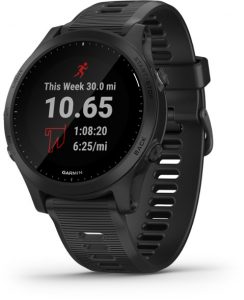
Design
The watch has the nice rounded-face that we are fans of, because it feels less bulky and more like, well, a watch. It comes in just one color — black — and may look more casual than the Fenix which we profile below. It has five buttons around the watch face, so if you are going for the “ultra-sleek” design, just keep that in mind. On the outside, it looks pretty much identical to the 935, and with a depth of 13.7mm, it doesn’t feel too “chunky” on most wrists.
But on the inside is where it is really a different device than its predecessors — let’s get to that next.
Features
This is a multisport-specific watch, which means it is also great for cycling, running, and swimming individually. The features of the 955 put it in a different category than the 935 and are a slight upgrade from the 945, which for some will make a no-brainer case for purchasing, and for others might be more than you want in a run and bike workout tracker. The watch can hold up to 200 hours of activity data, allowing you to go back and analyze your past several workouts without using an app. A whole slew of sensors gives you everything from heart rate to temperature, barometric pressure to a gyroscope and a compass.
Perhaps the most notable advancement is that you can play smartphone music from the watch, as long as you have bluetooth headphones to pair to the watch. This feature will impact battery life, but may well be worth it to not have to carry multiple devices. Music storage is up to 1,000 songs, which is impressive and on par with early-generation ipods. Pretty impressive.
As for sports, it does everything. Cycling, running, swimming, skiing, golf, elevation, etc. It provides pre-programmed maps of routes as well as ski runs. It integrates with your Strava or other 3rd party apps so you can have the watch be a one-stop-shop. Sleep tracking, heart rate tracking, and VO2 max tracking are all included — but nowadays most Garmins come with those features.
The watch also gives you more of the functionality you find in the Apple watch, such as the ability to pay at a scanner with your watch, as well as some preloaded workout maps. For all this, battery life is pretty good if you are using the basic functionality, but if you are wearing it and using all the functionality all day long, a daily charge will probably be needed.
Pros:
- All the best and latest functionality that Garmin offers for cycling, running, swimming, and triathlon
- Impressively sleek, although not as sleek as the 745
- Crazy battery life. Garmin says up to 2 weeks, and we think they are probably right.
- Built for hardcore endurance athletes
Cons:
- Watch face is big – might feel large on smaller wrists
- Most users will use a fraction of the total features
My Takeaway:
A great watch for athletes who value simple, but full, performance for all three triathlon sports, along with basic health measures. I used to think it was expensive, but as prices of other watches have increased, it’s now a bargain.
Garmin Venu 3
The Venu was introduced by Garmin relatively recently, making it the new kid on the block, and the company continues to invest in the lineup. What I have noticed with Garmin is that when they are going all-in on a certain lineup, you might want to consider upgrading, because it is likely that their future products (like their power meter bike pedals) will only be compatible with the newer versions.
I personally wore the Venu 3 for two months, and loved the functionality and feel, plus I’m a big fan of the lower price. For me, and my desire to track workouts and sleep, it gives me everything I need without spending twice the price on something that looks almost the same.
What I really like is that the watch is not as thick or big, making it feel very comfortable on the wrist. For those of you who have smaller wrists, or those of us who just prefer not to have something so bulky on the wrist, this is a very nice package. I did notice that the buttons are a little more recessed than the Fenix lineup, making them slightly harder to tap when on the move cycling or running.
The Venu did not skimp on the display – it really provides incredible resolution, which is nice given the fatigued state you will probably often be in while glancing at it. The touchscreen display is great, following Garmin’s foray into touchscreen functionality on its bike computers and other gadgets. I expect this to become the new norm for them. If you are coming from a non-touchscreen watch, it takes a little getting used to to not accidentally tap the face mid-workout. But it’s a quick learning curve.
If you want the the features Garmin gives you without going sky-high on price for a super advanced watch, I’d say the Venu 3 is the package that will work for 75% of athletes.

Design
The Garmin Venu 3 has a sleek, lightweight design that’s perfect for all-day wear, whether you’re crushing climbs or grabbing coffee post-ride. Its crisp AMOLED display is easy to read in bright sunlight, so checking your stats mid-ride is a breeze.
Features
The Garmin Venu 3 is packed with enough features to serve most triathletes well, starting with its multi-sport tracking for seamless transitions between swim, bike, and run. It’s got the built-in GPS and heart rate monitoring to dial in your pace and effort, whether you’re out on a long brick session or racing your first 70.3.
The sleep tracking and Body Battery feature help you optimize recovery, so you’ll know when to push hard and when to back off. Its training readiness insights and suggested workouts make it feel like you’ve got a coach on your wrist, fine-tuning your plan every day.
With a solid battery life, you can trust it to last through even the short road trips without a charge, and can definitely handle full-distance events. Plus, you can stream music directly from the watch or route your phone to it, so you’ve got your race playlist ready to fire you up without needing your phone.
Pros:
- Nice price point. Less expensive than most others on this list.
- Very good battery life
- Nice size on the wrist.
Cons:
- May lack some features that true power users (e.g. top 10%) might expect
My Takeaway:
A great watch at the right price point. It does everything you need your watch to do, in my opinion, and feels good to wear.
Polar Vantage V2 Watch
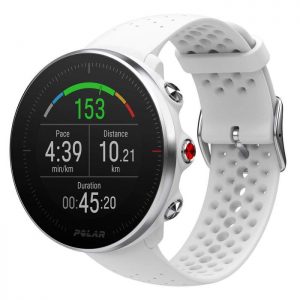
I’m a big fan of the underrated Polar Vantage lineup for triathletes, and have been for a few years.
Polar is a Finnish company that might not have the name recognition of Garmin, but they make a really good fitness watch. Polar’s late founder came from the EKG world, so he knew a thing or two about monitoring heart rates.
The Vantage V2 is in a new class of fitness wearables combined with simplicity and high performance of expensive watches in a single device. It is surprisingly functional and a great option for a triathlete who is willing to spend a few bucks on a good, accurate, and multi-functional watch. The professional triathlon racers will like the sleek design and the excellent waterproofing. It is a watch that can perform well in all three modes of triathlon.
If you want to save a few bucks, the Polar Vantage M (here) has the same design, but foregoes the run power meter, recovery tracking capability, and includes a battery with 30 hours of life (instead of 40). Otherwise, for most workouts, it will be similar.
Design
Unlike the bulky triathlon watches, the Vantage is sleek, and we like that they broke away from the square or rectangular design that has dominated the market for years. Theirs is a sleek round design, evoking memories of a more traditional wristwatch. Being less obtrusive than the other GPS-tracking watches, it looks perfect even on the skinnier wrists. The buttons are smartly placed so that you can operate the watch without any stress, and it should become second nature to you after a few good workouts.
The V2 model weighs in above 60 grams, about 50% more than the M model, due to the power functionality. It is not really any larger on the wrist, though, and the 20 grams of additional weight really are not noticeable in our opinion, due to the smart design of the watch.
When not in use during your workouts or recoveries, the Vantage doubles as a good-looking wristwatch with a regular (digitally created) watch face. That is a nice touch for folks who only want to own one watch. It has an impressive 2 weeks of battery life when in this smart watch mode.
Features
The Vantage is a perfect workout companion that functions as an activity tracker, precision monitor and fitness band. The watch has different modes depending on the activity you are performing, and while Polars used to be known for excelling on the run leg, we are pleased at the Vantage’s performance in all three sports. You can choose from “Aqua fitness” to “Yoga” and even “Classic skiing.” The waterproofing appears to work very well.
We like the built-in wrist heart rate monitor, and are big fans of the running power meter. That, and the “recovery mode” feature are the main things that separate the V model from the M. We have not looked in to the engineering on exactly how they accomplish it, but it is impressive nonetheless. One feature we like is the option of free training plans to be download to the watch, making it a true workout buddy.
One downside of the Polar brand is that the native app that goes with it is not quite a built-out as the Garmin. However, many people use these watches with 3rd party apps, like Strava, anyway.
The Vantage V is the sleekest watch on our list, if that is a priority for you. It is great to see Polar up their multisport game.
Pros:
- Sleeker than some of the competitors with similar features
- Excellent functionality across many sports
- Ability to download training plans to the watch
Cons:
- Polar’s app is not as widely used — no network effect
- Because they only make watches and HR sensors, no other compatible equipment like Garmin has
- Expensive
My Takeaway:
A watch worth considering if your top priority is having a sleek-looking and minimalist watch, and don’t need Garmin compatibility. Polar’s recent redesigns of the watch have made it underrated in my book.
Garmin Fenix 7
We were eager to try the Fenix 7 after having used the Fenix 6 or nearly a year. We really like the Fenix watch and recommend it — if you have the budget for it. The Fenix 7 takes the functionality that was found on the Fenix 5 and 6 and improves on it. It is also a more elegant, “dress-up friendly” watch than the gritty Forerunner.
There is also a Fenix 8 on the market today, a good watch no doubt with a slightly better screen, but you are going to pay about $250 more for it… and that is on top of an already-expensive price. For our money, the 7 gives you the features you need and keeps some money in your pocket.
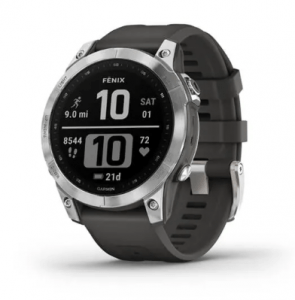
If there is one big thing to know about the Fenix 7, it is that it introduces touchscreen functionality to Garmin’s lineup. A big step.
The old Fenix watches were known for having spotty GPS coverage any time the cover became wooded or surrounded by buildings, and the 6 did a better job, and the 7 continues to build on that. If you are one of those cyclists, runners or triathletes who doesn’t mind making an investment in high-end gear, this might be the watch for you.
Made by Garmin, one of our favorite makers in the market, the Fenix has a brand standing behind it whose wearables we have been using for well over a decade.
There is also a version 7s — we assume the “s” is for “small”, which is a bit more compact but loses none of the functionality. I have actually been wearing that watch personally for a couple months and really like the sizing.
If you are a hard-core triathlete / trainer, you might prefer the Garmin 955. But if you want really good functionality plus a sleeker-looking watch, the Fenix ix a real nice choice.
Design
While the price tag might seem excessive, look at it this way: This is a beautiful watch. It is more than just a watch you might wear on a run or during a race. This is a watch you may find yourself wearing every day, all day, the way that others wear the Apple Watch. We like the size, the design of the watch face, and the color options that make it elegant for a night out. When you start to look at it that way, the price becomes something on par with a nice watch you may buy in a department store. The brush stainless steel case looks more like something you would wear to work than the Garmins of old that were bulky and built-for-workouts-only.
The thickness, at .6 inches, might feel a little “chunky” compared to the older models like the Garmin 645, or even compared to the 945 or especially the 745 (abobve), but will work for most people. It is perhaps a little thicker than the Polar (.5″) but the design of the watch still makes it feel nice on the wrist. The 7s, which isn’t thinner but has a smaller face diameter, feels more compact on the wrist than the 7.
Features
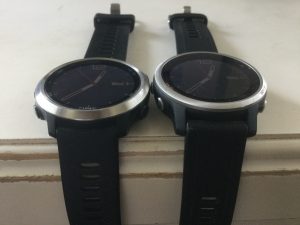
The Fenix 7 has a lineup of features that put it at the top (along with others) of the best on this list. To start, it can handle all three sports with ease — including being able to go 100 meters under water (as if anyone ever needed that capability). The watch includes a recovery advising feature which can allow you to monitor your non-workout time and activity, as well as the VO2 monitor. We like the running features in particular, including the ability to measure stride length and lactate threshold.
We really like the touchscreen – you will get hooked on it quickly. The Fenix 7 also offers more battery management options than previous Garmins.
Very important for many more dialed-in cyclists and triathletes, the 6 and 6s IS compatible with the new Garmin Rally power meter pedals. Older watches from Garmin are not necessarily compatible, so it is something to be aware of. The 7 and 7s also both have the body battery feature which tends to be popular with Garmin users.
Like the 945, you are going to be able to use this watch for everything from golf to skiing as well. And it is just as useful when you are not working out, monitoring everything from your sleep to water intake to resting heart rate.
The watch has a swim lap counter, a nice feature allowing an athlete to not have to count laps in their head. It also includes all the features of a tracker, including daily steps and other metrics. When you appreciate the fact that this is really your dress-up watch, fitness tracker, and workout watch in one, the price tags gradually becomes more digestible.
Many pre-loaded trackers and routines allow the watch to be used in many different settings. It even has settings for golf and skiing.
If you have the budget, and one a high-performing watch that really is several watches in one, give the Fenix 6 a serious look.
Pros:
- Functionality for nearly every activity under the sun
- Great 24/7 vital stats, such as HR and sleep
- Compatible with other Garmin gear, like power meter pedals and bike computers
- Touchscreen abilities
Cons:
- Expensive
- Will have more functionality that some people need
- A little chunky if you are used to a slim watch
My Takeaway:
A really good all-around Garmin watch if you want just a little more flair and style than the Forerunner but don’t need to splurge on the Epix. This is the one I wear everyday.
Fitbit Flex 2

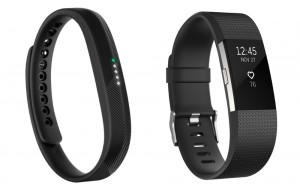 OK, we might get a little flack for this one, but the fact is not everyone needs a decked-out watch that can estimate your VO2 max and tell you how to get home on your 100 mile bike ride.
OK, we might get a little flack for this one, but the fact is not everyone needs a decked-out watch that can estimate your VO2 max and tell you how to get home on your 100 mile bike ride.
The Fitbit Flex is not a triathlon watch in the same way that the others are triathlon watches. To be clear, it is not in the same category as the Garmins and Polars.
This is an option if you do not need to actively monitor each minute of your workout, and can live without some of the data that has become so commonplace with trackers. It is also a good option if you want to save a pile of money, and just track your exercise.
Do not buy this, say as a gift, for that Type A, hardcore triathlete in your life. Rather, this is a nice compromise choice for people who don’t want a watchface on their wrist.
Fitbits are not often considered in the same league as Garmins and other sport-specific watches, and that fact is they are not. But sometimes, when it comes to multisport training, watches like the flex are worth a look. Despite having no display and heart tracking, Fitbit Flex 2 is worth the compromise for many, and comes at a significantly lower price. Thanks to its band-like design and effectiveness even in the water, it is a basic tracker that multisport athletes can use for all three sports. It has a long battery life and sleeker design with the ability to track your all the activities and sleep. It is connected to your phone and shows all the activities through an application.
With the strong brand of Fitbit, and the likelihood of the Fitbit lineup growing in the future, it is intriguing for triathletes to think about building their training database on the Fitbit platform. If you simply need something that can track your time and distance in the water, on the bike, and during the run, the Flex 2 fits that bill.
A very important distinction, though, is that the Flex 2 is not meant to be used to glance at your speeds and mileage within a workout — and that is exactly what many triathletes need. Instead, it is a great tool for looking back at your workouts over time and understanding how your training has been trending. Unlike the other options here, it is meant to be worn around-the-clock, so you can track much more than workouts. Such trackers have been shown to make a difference on physical activity and sticking to some regimen.
So think of the Fitbit Flex as a training and performance tracker, not a watch to actively use during your training. If that type of thing is your speed, then the Flex is worth a serious look. It is also not going to be compatible with most power meters, if that is important to you.
Pros:
- Slim and skinny. You will forget it is there.
- A good latent or passive fitness tracker
- A basic fitness tracker for those who don’t need all the functionality
Cons:
- Not intended to actively manage your workouts (readout is too small)
- Limited functionality for people doing many sports
My Takeaway:
To be clear, the Fitbit is not in the same league as the others on this list. However, sometimes people just want a simple tracker that is small and inexpensive, and this can fit that bill.
Wahoo Rival Watch
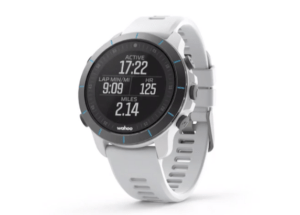
The Wahoo RIVAL watch impresses with its features, squarely competing with the heavy hitters like Garmin’s Forerunner and Fenix series. During my test runs and rides, I grew to really like the watch, although Garmin loyalists might never get fully on board. For someone who is going all-in on the Wahoo brand, though, the RIVAL is a bit of a no-brainer.
Design
The Wahoo RIVAL Smartwatch has an elegant design characterized by a round face and a highly legible display. The watch’s robust construction conveys durability, suitable for a range of activities. I find it comfortable, and the adjustable strap seems to be better quality the standard hard rubber strap found on base Garmin models.
Regarding build quality, the RIVAL holds up well even during demanding cycling and swimming sessions. With water resistance up to 50 meters, it gives you more water range than 95% of us will ever need. The tactile buttons on the watch’s side are well-positioned, providing a satisfying click when pressed.
I really like the Rival’s display. Sporting a high-resolution, full-color screen measuring 1.2 inches in diameter, it rivals the Garmin Forerunner 945 in size and clarity. The Gorilla Glass lens ensures resilience against scratches and impacts, making it suitable for intense workouts. The screen’s brightness levels are easily adjustable for optimal visibility in varying lighting conditions.
Features
The most obvious feature benefit of the Wahoo RIVAL is its seamless integration with other Wahoo products, such as the TICKR heart rate monitor and ELEMNT cycling computers. This interconnectedness provides users with a holistic view of their fitness progress across multiple devices, particularly favoring cyclists as Wahoo is really a cycling company at heart.
One notable feature is the ability to switch between different watch faces effortlessly, enabling users to tailor the watch’s appearance to their preferences and activities. Furthermore, the RIVAL incorporates a button-driven interface that eliminates the need for touchscreen swipes, ensuring reliability during high-intensity workouts.
You are going to get all the fitness and health tracking that you would expect in a watch of this range — heart rate, sleep, and other estimations for your fitness and training load. That has all become table stakes at this point, and Wahoo delivers.
Finally, I would put the watch’s battery life at well above average for the class, at about 14 days. Compare that to some of the Garmin models where you will realistically get just 9 days or so.
Pros:
- Great battery life
- Surprisingly vivid display
- More comfortable wristband than other brands
Cons:
- Not compatible with the Garmin family
- Perhaps a little bike-centric, but not terribly
My Takeaway:
If you are starting to get in to the Wahoo lineup with your bike computer, trainer, and other gear, the Wahoo Rival is a legitimately nice training watch to add to that family. The Wahoo is probably best-suited for people who view themselves as cyclists-first. That is really where it shines, versus the other sports.
Suunto Vertical Watch

The most recent high-quality multisport watch to hit my radar has been the Suunto Vertical. I’ve had the privilege of putting the Suunto Vertical Watch through its paces. Designed with endurance athletes in mind, this watch offers a unique design and feature set that make it a strong choice for people who want data-driven training.
Design
The Suunto Vertical Watch fits nicely on the wrist of most athletes, although petite builds might consider the Peak Pro lineup. The Vertical boasts a rugged and durable design, perfectly suited for the demands of outdoor sports and triathlon training. Its stainless steel bezel and sapphire crystal lens give it a bit of a stylist flair for those times when you are not using the watch to workout. It has water resistance of up to 100 meters, better than most of its competitors.
Like the Wahoo and Garmin options, Suunto has nailed the easy-to-read display. The high-resolution screen ensures that you can check your vital metrics, even during intense workouts or in bright sunlight. Its intuitive button interface allows for swift navigation, a crucial factor when you’re on the move or in the middle of a triathlon transition.
Functionality
Suunto Vertical gives great functionality for for triathletes and cyclists. Its GPS tracking is remarkably accurate, providing detailed data on distance, pace, and elevation gain, which is crucial for both training and race analysis. The watch’s barometric altimeter, compass, and thermometer come in handy for navigating unfamiliar terrains during outdoor adventures or long rides, and you are going to get all of the health information you would expect in a watch of this price.
As for the data part, you use the Suunto watch with the Suunto app, which will help you keep track of both your training and health stats. It is intuitive and easy-to-use, and for most people it probably has a shorter learning curve than Garmin Connect. It actually reminds me a bit more of Strava than Connect, as the app feels more centered around your workouts.
Pros:
- Outstanding battery life
- Crazy deep water resistance, so a good option for divers
- Suunto app is surprisingly intuitive to use
Cons:
- Smaller athletes might find the watch a bit bulky
- Get get expensive, up there with the high-end Garmins in terms of price
My Takeaway:
For people who are willing to branch out away from Garmin and Wahoo, the Suunto is a very capable watch that uses a surprisingly efficient and intuitive data app. I’d like to see a little more run-time with how quickly the GPS locks-in. It was a problem on prior models (watch took too long to find its GPS at the start of a workout) but my last test was much better. Perhaps they solved it.
Non-Swim Multisport Options
The devices listed above are all listed because of their ability to handle all three sports in a triathlon – the swim, the bike, and of course the run. It is always a bit of a debate on if it is necessary to use your watch on the swims, or simply save it for the bike and run. It depends on how serious of a swimmer you intend to be, and how much open water swimming you plan to do (we find GPS watches of limited value in a pool), and it isn’t like you are going to glance at your swim pace often as you would during a run. We will say that the one time a watch is kind of nice in the water is for knowing the distance that you swam — open water swims are notoriously “approximate” in their distances.
If you are willing to not wear a watch in the swim and only track your cycling and running performance, your options open up considerably. If you are not taking them in water, you can consider several more Garmin and Fitbit models, including the Fitbit Blaze workout watch.
For years, we have not worried about our swim times and only put the watch on at T1, when we are ready to hop on the bike. It has worked just fine.
How I Tested the Watches
I have used all these watches.
I am a Garmin user, so because of my coaching and writing, I usually have plenty of Garmin watches coming across my desk. In other cases, I might swap watches with one of my training partners or clients for a couple days, given both me and them a chance to see what a different watch has to offer.
I am usually looking for the real-world takeaway stuff, because anyone can find the specs on the web. I’m trying to determine things like:
- Is the watch comfortable on the wrist?
- Are the buttons and controls intuitive?
- Is the watch easy to use while on the move, working out?
- Does the battery life impress?
- How compatible is the watch with my other training tools, like apps or bike components
In the end, my question is really a simple one: If this was the only watch I owned, would I be happy with it?
Compatibility with Triathlon and Cycling Training Apps
Most watches are now more than just wearables — they also are compatible with some of the better training and fitness apps on the market. That is important if you want to integrate all of your workout information into one, consolidated log.
Major manufacturers have their own platforms for tracking and planning your training, including Garmin Connect, Polar Beat, and Fitbit’s popular Fitbit Dashboard. All will help you analyze your workouts, keep track of what you did and when, and help you share the information with others.
Some of the other apps to keep in mind that could be useful include:
- Strava – the popular cycling and running workout tracker and community. All of the watches recommended above demonstrate some level of compatibility with Strava. We are huge fans of Strava, mainly because so many people are using it. It is the network effect.
- Smart Cycling Trainers – The advent of smart bike trainers has brought a sophistication to indoor cycling that did not exist before. Many third-party apps, such as the one from Zwift, are able to sync with your Garmin, Polar, and other watch data for a complete analysis of your training.
- Other Run Apps — Apps like Runkeeper and Runtastic are generally compatible with the data from your watch. However, these apps are really meant to be used on your phone.
- Nike+. Nike+ claims to be the most popular mobile fitness app out there, with an estimated 30 million+ users. Luckily, Nike has made the product compatible with many of the watches listed above. They have a special affinity for the TomTom, a product they have co-branded with “powered by Nike.”
Other Alternatives to a Triathlon Watch
We love a good triathlon watch because it can be so all-purpose, but there are some other good alternatives, too. It really comes down to your style and personal preference for your rides. Here are two options we see lots of triathlons go with instead of a watch.
A bike computer can be a nice option for cycling-first triathletes because it allows you to always know that you are going to have your stats on the bike, in a way that is conveniently mounted on your cycle. We believe it slightly adds to the bike safety, because glancing down at a well-mounted computer is often simpler than looking at your wrist, and adjusting the read (pressing a button) is much safer on a computer than fiddling with your watch. These bike computers have come a long way in recent years, and are now often GPS units, and very compatible with Strava and other smart phone features. The downside, of course, is that you are not going to use a bike computer on your run or swim.
In the bike computer market, we are anxiously anticipating the next Karoo model, and will write on it soon.
Many triathletes simply use their smart phone while training, where you can download a plethora of apps to help track your mileage, distance, and speed, such as the Nike+ app or Strava (we suggest Strava). This can be a good option, but you can’t use it in the swim, and you are not going to have the same battery life that you would in the typical training watch or bike computer.
See the video to the right for a quick tutorial on pairing your heart-rate monitor watch to an app like Zwift. The video is geared for a run, but the concepts apply just as well to the cycling features.
Do you Really Need All of that Functionality in your Multisport Watch?
It depends. For many, the trove of data that a multisport watch can provide is a perfect. For others, it is a little over-the-top. The fact is that if you simply want to know how many miles you ran, and how fast, many trackers can do that.
For people who are trying to add precision to their training, though, these wearables are really pretty impressive. You can track everything from your sleep, to your 24-hour heart rate, to your stress level, to your workout intensity patterns. Heck, you can even track your downhill ski runs next time you are in Aspen.
Some people will want that, others won’t. We suggest thinking about how you will use a wearable before buying one. You will pay a little more for every bit of functionality that you add. If personal experience is any indication, there is a pretty good chance that you will find you use more of the functionality than you originally assume, once you start using the watch on a daily basis — and it might not be the features you originally expected to use.
Final Thoughts on Tri Watches
The choice of a triathlon or multisport watch depends on your usage. If you are a professional, elite, or aspiring elite triathlete, or you just like knowing that you have the best gear out there, you should go with Forerunner 945. It has all the necessary features to help you during your training. For all the fitness enthusiasts not willing to spend quite as much, the other three watches are definitely good enough to provide training precision and some motivation on your runs, bikes, and swims. We have to say, though that the Polar Vantage is coming on strong with their latest round of enhancements, especially if you do not need a device that tracks your every way moment.
We should note that once you get used to the software and app that goes along with one brand of watch, there can be some efficiency to staying with the brand — especially if you don’t rely on outside apps to analyze and track your data. That would be one reason to simply upgrade within the brand that you already use, if you use a watch already.
Some may ask the question, “why not just use your phone as a tracker?” We prefer a watch for a few reasons. First, it is built-for-purpose, and fits naturally on your wrist during even the hardest workouts. Second, the right watch can be used on your swims — you would never do that with a phone. Third, the battery life on a tri watch is far superior to that of your typical phone — a factor on your longer workouts or when starting out with less than a full charge. Finally, a watch will excel in poor weather — cold winter runs, or a rainy bike ride — when a phone might underperform or even get quite damaged.
This technology is changing so fast, though, and the peripherals you can use with the watches are in such rapid advancement, that we would consider this a ~2 year investment, and at that time you will probably be looking to upgrade.
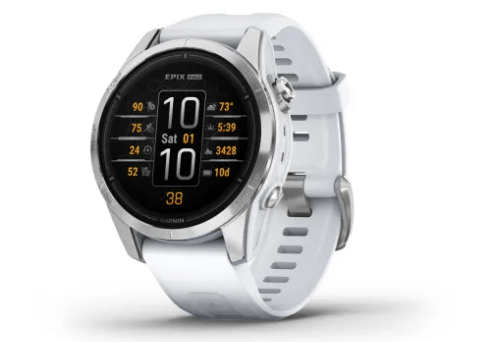



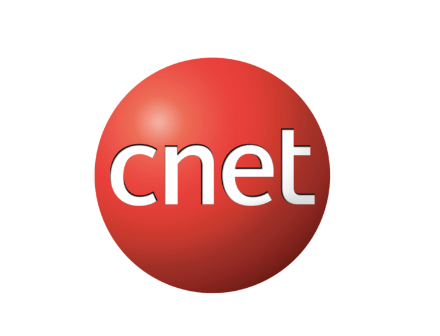



I think you may update the list with COROS watches. Coros Pace 2 is the cheapest multisport GPS watch for triathlon without the bell & whistles and very accurate GPS function.
I would love for you to look at the COROS watches, I have been seeing reviews that it is far superior to Garmin and at a much better price point. Recently bought the Apex 42 mm and never looking back at my use of Garmin for the past 15 years.